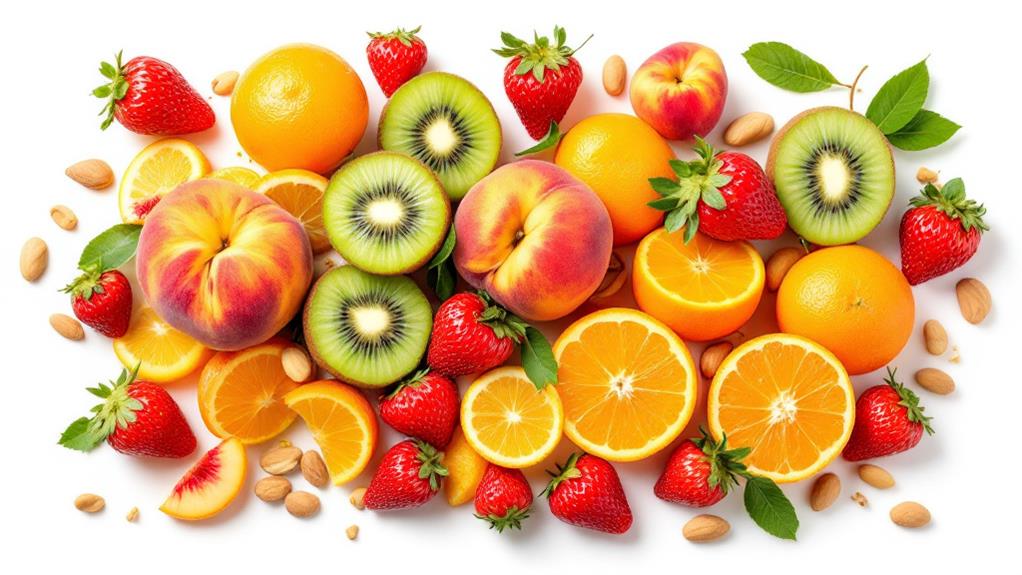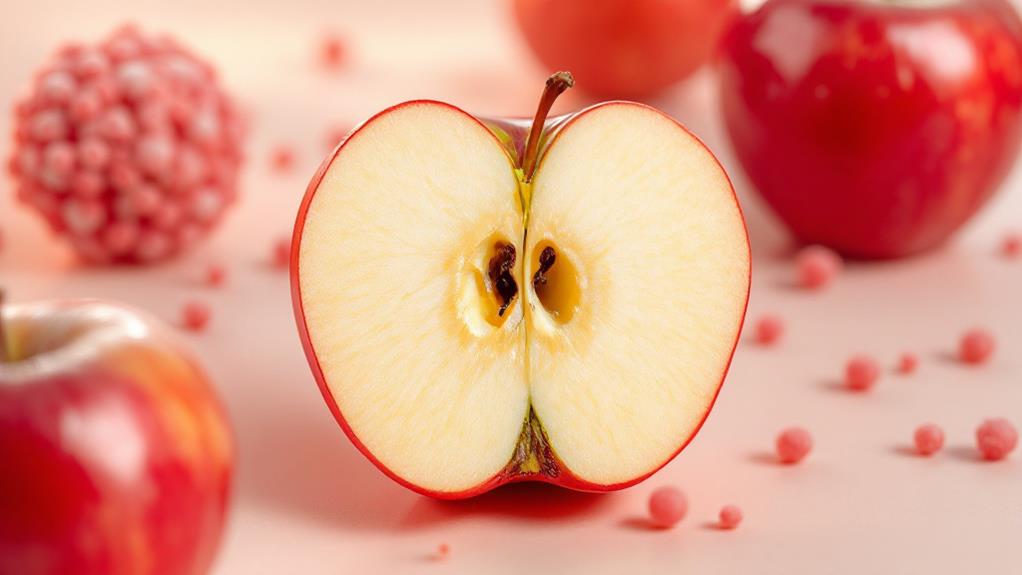Common Fruits That Can Cause Allergic Reactions: What You Should Know

If you're prone to allergies, certain fruits might trigger reactions. Apples, peaches, and kiwis are top culprits due to proteins that mimic pollen. Symptoms can range from mild itching around your mouth to serious reactions like anaphylaxis. Oral Allergy Syndrome is common, particularly if you have hay fever, causing discomfort with these fruits. Cooking apples and peaches might help reduce allergenic proteins, but raw consumption often poses a risk. If you suspect a fruit allergy, it's essential to consult healthcare professionals for testing and management. Exploring more can offer deeper insights and help you avoid allergic pitfalls.
Understanding Fruit Allergies
Fruit allergies can be surprisingly complex, often leaving you wondering why something as wholesome as fruit might cause discomfort. Your immune system, designed to protect you, sometimes mistakenly identifies certain fruits as harmful invaders. This misidentification triggers the release of histamine and other chemicals, leading to allergic reactions. Symptoms can range from mild oral discomfort to severe systemic responses, depending on your sensitivity and the specific fruit involved.
A common manifestation of fruit allergies is Oral Allergy Syndrome (OAS). If you experience OAS, it's likely because proteins in certain fruits mimic those found in pollen, which you're already sensitive to. This cross-reactivity primarily causes localized symptoms such as itching or swelling in the mouth and throat, making each bite of your favorite fruit potentially uncomfortable.
The severity of these allergic reactions varies greatly among individuals. While some might only feel a mild itch, others could face more severe symptoms, including gastrointestinal distress or respiratory issues. To pinpoint your specific triggers, healthcare providers often use a combination of a thorough medical history, clinical evaluations, and skin prick tests. These help tailor avoidance strategies, ensuring you stay safe while managing your fruit allergies.
Common Allergenic Fruits
Submerge yourself in the realm of common allergenic fruits, where everyday favorites like apples, peaches, and kiwis can unexpectedly cause discomfort for those with sensitivities. These fruits, while delicious and nutritious, are known culprits of allergic reactions, particularly among individuals with Oral Allergy Syndrome (OAS). When you bite into an apple or peach, you might experience itching or swelling in your mouth, lips, and throat, which are hallmark symptoms of OAS.
Apples often contain heat-labile or heat-stable allergens, with severe symptoms sometimes linked to the fruit's skin. Peaches, primarily causing allergies in Mediterranean countries, can also trigger reactions in those allergic to other fruits in the Rosaceae family. If you find yourself reacting to kiwis, it might not be just the fruit itself. Kiwi allergies can arise from direct sensitization or due to cross-reactivity with birch pollen and latex, potentially leading to a range of symptoms from mild gastrointestinal distress to more severe systemic reactions.
Navigating the world of common allergenic fruits requires awareness and caution, especially if you're prone to allergic reactions. Understanding these potential triggers can help you manage and possibly avoid uncomfortable or severe symptoms.
Apple Allergy Insights

As you investigate the intricacies of fruit allergies, apple allergies stand out with their unique characteristics and triggers. When dealing with an apple allergy, you may encounter two distinct forms. The initial is linked to birch pollen sensitization, often resulting in oral allergy syndrome (OAS) with mild allergic reactions like itching and swelling around your mouth, lips, and throat. This happens because your immune system confuses apple proteins with birch pollen.
The second form involves a heat-stable allergen found just beneath the apple's skin, which can lead to more severe reactions. This allergen doesn't break down easily, making it a concern if you're highly sensitive. Curiously, the geographic prevalence of apple allergies is higher in cooler regions of the northern hemisphere, where birch pollen is widespread.
If you face apple allergies, you might also react to other fruits in the Rosaceae family, such as peaches and cherries, due to cross-reactivity. However, there's a silver lining: cooking apples can greatly reduce the risk of allergic reactions. The heat inactivates the offending allergens, providing a safer way for you to enjoy this popular fruit.
Peach Allergy Details
While peach allergies might not be as widely known as those to peanuts or shellfish, they present significant challenges, especially in Mediterranean countries where they're most prevalent. If you've got a peach allergy, you might experience a range of allergic reactions, from mild itching and swelling to severe anaphylaxis. The major allergen in peaches is heat-stable and found mainly under the skin of the raw fruit, making it particularly potent when consumed fresh. This means even a small bite of raw peach could lead to a serious reaction.
If you're allergic to peaches, it's essential to avoid both fresh and processed peaches. Unfortunately, these allergies often coexist with sensitivities to other fruits in the Rosaceae family, like apples and apricots. You should also be cautious about cross-reactivity with certain tree nuts, such as hazelnuts and walnuts, which can trigger similar symptoms.
Managing a peach allergy requires vigilance, particularly in regions where peaches are a dietary staple. Always check food labels and be aware of potential cross-contamination in kitchens. If you suspect a peach allergy, consult an allergist to investigate testing and management strategies to keep you safe.
Kiwi Allergy Factors

Peach allergies may have their complexities, but kiwi allergies bring their own set of challenges that can't be overlooked. When dealing with a kiwi allergy, your immune system mistakenly identifies proteins in the fruit as harmful, triggering allergic reactions. These reactions can range from mild, such as skin rashes and gastrointestinal disturbances, to severe, including life-threatening anaphylaxis.
One of the tricky aspects of managing a kiwi allergy is its potential cross-reactivity with other allergens. If you're sensitive to birch pollen or latex, you might experience similar reactions when consuming kiwi. This cross-reactivity complicates both diagnosis and management, requiring you to be vigilant about what you eat. The variability in the severity of reactions means you must monitor your dietary intake closely and be aware of potential triggers.
It's crucial to consult healthcare professionals if you suspect you have a kiwi allergy. They can provide guidance and help you develop a management plan tailored to your condition. Awareness and preparation are key. By understanding your triggers and maintaining open communication with your healthcare provider, you can effectively manage your kiwi allergy and reduce the risk of severe reactions.
Oral Allergy Syndrome
Have you ever noticed an itch or tingle in your mouth after biting into a piece of fruit? If so, you might be experiencing oral allergy syndrome (OAS). This condition occurs when your immune system recognizes proteins in certain fruits as similar to pollen proteins, triggering an allergic reaction. It's particularly common in people with hay fever. For those affected, eating raw fruits like apples, peaches, cherries, and kiwi can lead to symptoms after eating, such as itching or swelling in the mouth, lips, and throat.
These symptoms typically appear within minutes to two hours of consuming raw fruits and usually resolve within an hour. Notably, cooking these fruits can inactivate the allergens, often preventing any reaction. About 33% of people with hay fever are allergic to profilins, the proteins that trigger OAS, which means they might react to multiple fruits.
To determine if you're allergic to one or more fruits, a diagnosis involves reviewing your medical history and allergic reactions. A skin prick test might also be conducted to confirm sensitivity to specific fruits. Being aware of OAS can help you manage your symptoms and enjoy fruits safely.
Symptoms of Fruit Allergies
With respect to fruit allergies, symptoms can vary widely, ranging from mild to potentially severe reactions. Symptoms usually appear quickly after eating the offending fruit, with Oral Allergy Syndrome (OAS) being a common manifestation. If you have OAS, you might notice an itchy mouth or scratchy throat shortly after consuming certain raw fruits. This response is related to proteins in the fruit that your immune system mistakes for pollen, triggering a reaction.
In mild cases, you may experience localized symptoms such as itching and swelling around your mouth, lips, and throat. These symptoms often resolve quickly, especially if you stop eating the fruit or if it's cooked, as cooking can deactivate some allergenic proteins. However, food allergies can sometimes lead to more than just an itchy mouth. Some people might experience gastrointestinal discomfort or even hives, which indicates a more serious reaction.
While a serious reaction like anaphylaxis is rare with fruit allergies, it's significant to be aware of the possibility. The severity of symptoms can differ greatly from person to person. It's essential to recognize your body's responses and seek medical advice if you suspect a fruit allergy.
Severe Reactions and Risks
Severe allergic reactions to fruits can be life-threatening, and it's important to be prepared. When your immune system no longer tolerates certain fruits, it can lead to severe allergic reactions, including anaphylaxis. This condition can cause your airways to swell, making it difficult to breathe, and can lead to a dangerous drop in blood pressure. These symptoms often appear quickly after you consume raw allergenic fruits, and about 1.7% of individuals with fruit allergies might experience anaphylactic shock. As a result, understanding the severity of this risk is key.
If you've been diagnosed with a fruit allergy, always have an epinephrine auto-injector (AAI) on hand. This device is critical for managing severe reactions like anaphylactic shock. When early symptoms such as throat tightness or breathing difficulties occur, using an AAI can be life-saving. Immediate medical intervention is necessary to prevent life-threatening complications. Awareness and preparation can greatly reduce the risks associated with severe allergic reactions. Remember, the key to safety is recognizing symptoms early and acting swiftly with the tools and knowledge you have at your disposal. Stay vigilant and prepared to protect your health.
Diagnosis and Testing

Diagnosing fruit allergies often requires an extensive approach to guarantee accuracy. You'll start by providing a detailed clinical history to your allergist, which includes recounting any previous allergic reactions to specific fruits. This information is essential for narrowing down the potential allergens involved. A common diagnostic tool used is the skin prick test. During this procedure, small amounts of fruit allergens are applied to your skin to check for any allergic reactions, like redness or swelling.
Additionally, blood tests can be conducted to measure IgE antibodies specific to certain fruit allergens. If your body produces these antibodies, it can indicate a potential allergy. Another method, the oral food challenge, involves consuming the suspected allergen under strict medical supervision. It's a reliable way to confirm a diagnosis, as it directly observes your body's reaction to the fruit.
Understanding cross-reactive allergens is important, especially if you have pollen allergies. Some fruit allergies are linked to these cross-reactions, meaning identifying them helps in crafting an accurate diagnosis. By following this thorough testing approach, you'll gain a clearer understanding of your fruit allergies and potential triggers.
Management and Avoidance Strategies
Effectively managing fruit allergies starts with identifying the specific allergens you need to avoid. Knowing which fruits trigger reactions allows you to eliminate them from your diet and reduce the risk of exposure. Here are some key strategies to help you manage and avoid fruit allergies:
- Complete Avoidance: Steer clear of both fresh and processed forms of allergenic fruits. Cross-contamination during food preparation is a real risk, so always check labels and ask about ingredients when dining out.
- Emergency Treatment Plan: Always have an epinephrine auto-injector within reach if you're at risk of severe reactions like anaphylaxis. This device can save your life in an emergency, so make sure you know how to use it and that it's up to date.
- Consult Healthcare Professionals: Regularly see an allergist to tailor a personalized management plan. They can help you track potential cross-reactive allergens and suggest alternatives that might not trigger your allergies.
Cooking fruits can sometimes reduce their allergenic properties, making them safer for you. However, if your allergies are severe, complete avoidance might be necessary. Stay informed and vigilant to manage your fruit allergies effectively.




